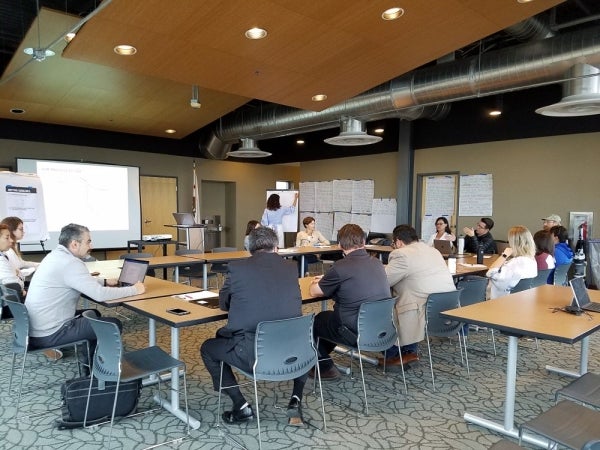Inclusive Engagement Techniques and Approaches
Focus Groups

What is it?
Focus groups are a way of interviewing a group of people to gather qualitative insights about a project. In a focus group, a small number of participants (typically no more than 10) meet once to provide their insights for a pre-defined purpose. Focus group participants are selected to either be a representative sample of the public or provide a certain perspective staff wish to learn more about. Focus groups can be held in-person or virtually.
When to use it
Focus groups can help staff identify key issues, understand community perspectives or gather input about more complex topics through open-ended questions. They are especially useful for gathering feedback that might not surface in surveys or one-on-one interviews. Focus groups can complement quantitative data by providing a clear picture of what people think and feel.
How to do it
Before
- Determine the desired input from the focus group and participant selection criteria.
- Recruit participants according to the selection criteria through outreach channels such as email notifications, flyers or social media.
- In addition to standard outreach channels, directly contact organizations that may be able to spread the word among people who fit the selection criteria.
- Focus groups are highly facilitated engagement events. Select a facilitator. Ensure City staff subject matter experts are available to address questions the public may have.
- Develop an agenda that includes:
- The project background
- The focus group’s purpose/how the information will be used
- Open-ended questions to ask the focus group
- Choose a method for capturing public input and prepare all necessary materials.
- Methods may include recording the meeting, using a notetaker or writing on flip charts.
- Choose venues that are fully accessible, including parking, entrances and restrooms. Choose venues near transit and that have adequate parking.
- When scheduling the focus group date and time, consider participants’ availability.
- Send out focus group invitations and material for pre-reading, if applicable.
- If in-person, organize the venue in a way conducive to open conversation, such as using round tables or arranging chairs into a circle.
During
- The facilitator should share productive engagement event guidelines or create engagement event agreements.
- The facilitator should guide the conversation and create an environment where participants feel comfortable sharing their candid thoughts.
- Document and record input.
- If demographic makeup of the group was not predetermined, collect optional demographic information at the end from participants in written form, and note any next steps or future opportunities for engagement.
After
- Transcribe the collected input and analyze major themes from the information gathered.
- Follow up with participants to thank them, share findings and reiterate how their input will influence the project/decision-making process.
Resource considerations
![]()
Cost: Minimal to Moderate
Costs may include printing materials, consultant facilitator(s), venue rentals and participation support.
![]()
Time: Moderate
Focus groups typically meet once but require thorough preparation. It may take a few months to recruit participants, prepare materials and host the focus group. Focus groups themselves typically last no more than two hours.
![]()
Capacity: Moderate
Three to four staff may be needed to recruit participants, prepare materials, record input and analyze findings.
Other considerations
- Consider any audiovisual needs (projector, microphones, screen, etc.) for the focus group.
How to make it more inclusive
- Identify any language access needs in advance and consider providing participation support.
- Host the focus group at a familiar location for participants.
Inclusive Engagement Techniques and Approaches
- Introduction
- Appreciative Inquiry
- Arts-based Engagement
- Briefings
- Comment Forms
- Community Cafés
- Community Mapping
- Community Office Hours
- Email Notifications
- Engagement through Service
- Fact Sheets
- Flyers
- Focus Groups
- Game-based Approaches
- Hotlines
- Information Kiosks
- Interviews
- Meeting in a Box
- Mobile Engagement
- News Releases
- Newsletters
- Open Houses
- Participation Support
- Pop-Up Events
- Project Models
- Project-specific Groups
- Public Meetings
- Public Service Announcements (PSAs)
- Social Media
- Surveys and Polls
- Tours and Field Trips
- TV/Radio/Podcast Interviews
- Vision Walls
- Web-Based/Hybrid Meetings
- Webpages
- Workshops


 Inclusive Public Engagement Guide
Inclusive Public Engagement Guide